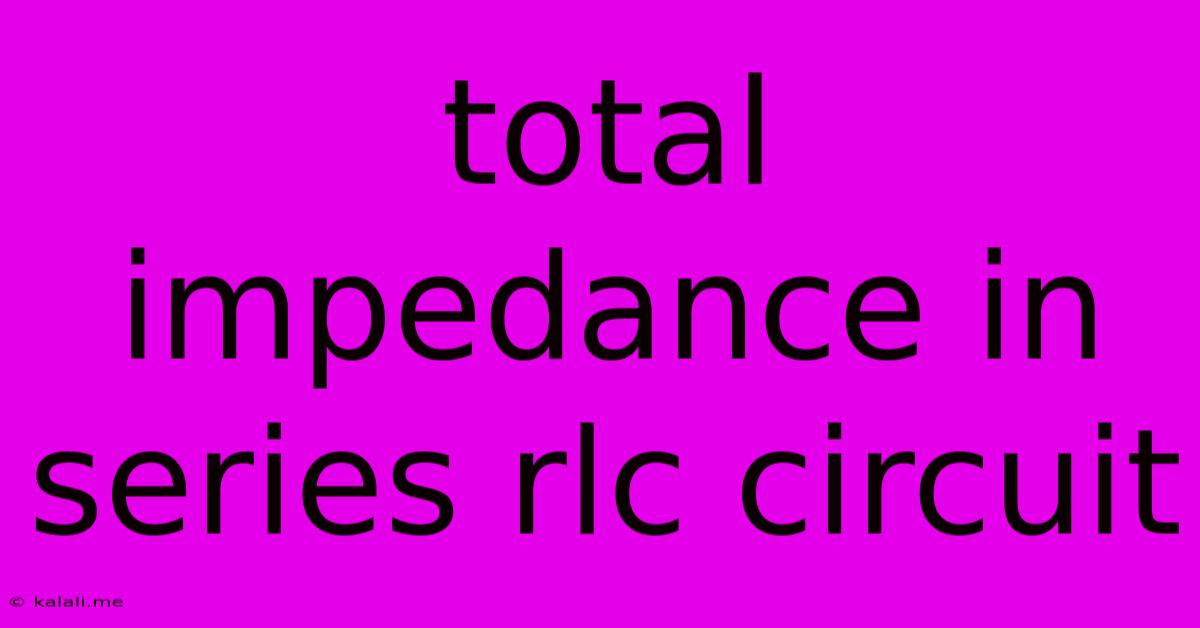Total Impedance In Series Rlc Circuit
Kalali
Jun 13, 2025 · 3 min read

Table of Contents
Understanding Total Impedance in a Series RLC Circuit
Meta Description: This article provides a comprehensive guide to understanding total impedance in a series RLC circuit, covering calculations, phase relationships, and the impact of resonance. Learn how to analyze and calculate impedance in series RLC circuits.
Calculating the total impedance in a series RLC circuit is crucial for understanding the behavior of the circuit and predicting its response to different frequencies. Unlike simple resistive circuits, the impedance in an RLC circuit is frequency-dependent and involves the interplay of resistance (R), inductance (L), and capacitance (C). This article will break down the process, clarifying the concepts and offering practical insights.
What is Impedance?
Impedance (Z) is the total opposition to the flow of current in an AC circuit. While resistance (R) simply opposes current flow, impedance encompasses resistance and the opposition offered by reactive components – inductors (L) and capacitors (C). These reactive components store energy, leading to a phase shift between voltage and current.
Impedance in a Series RLC Circuit: The Formula
In a series RLC circuit, the total impedance is the vector sum of the individual impedances of the resistor, inductor, and capacitor. This is because the voltage across each component is in phase with the current for the resistor, lags the current for the inductor, and leads the current for the capacitor. The formula for total impedance (Z) is:
Z = √(R² + (XL - XC)²)
Where:
- Z is the total impedance in ohms (Ω)
- R is the resistance in ohms (Ω)
- XL is the inductive reactance in ohms (Ω), calculated as XL = 2πfL (f is frequency in Hertz, L is inductance in Henries)
- XC is the capacitive reactance in ohms (Ω), calculated as XC = 1/(2πfC) (f is frequency in Hertz, C is capacitance in Farads)
Understanding Reactance (XL and XC)
-
Inductive Reactance (XL): An inductor opposes changes in current. The higher the frequency or the inductance, the greater the inductive reactance, meaning more opposition to current flow.
-
Capacitive Reactance (XC): A capacitor opposes changes in voltage. The higher the frequency or the lower the capacitance, the lower the capacitive reactance, meaning less opposition to current flow.
Phase Relationships and Impedance
The relationship between XL and XC significantly impacts the total impedance and the phase angle (φ) between voltage and current.
-
XL > XC (Inductive Circuit): The circuit behaves predominantly inductive. The current lags the voltage. The impedance is high.
-
XL < XC (Capacitive Circuit): The circuit behaves predominantly capacitive. The current leads the voltage. The impedance is high.
-
XL = XC (Resonance): This is a critical condition called resonance. The inductive and capacitive reactances cancel each other out (XL - XC = 0). The total impedance is equal to the resistance (Z = R), reaching its minimum value. At resonance, the current is at its maximum for a given voltage.
Calculating Total Impedance: A Step-by-Step Example
Let's consider a series RLC circuit with R = 10Ω, L = 1mH, C = 1µF, and a frequency of f = 1kHz.
-
Calculate XL: XL = 2πfL = 2π * 1000Hz * 0.001H ≈ 6.28Ω
-
Calculate XC: XC = 1/(2πfC) = 1/(2π * 1000Hz * 0.000001F) ≈ 159.15Ω
-
Calculate Z: Z = √(R² + (XL - XC)²) = √(10² + (6.28 - 159.15)²) ≈ 152.6Ω
In this example, the circuit is predominantly capacitive because XC > XL.
Resonance and its Significance
Resonance is a crucial concept in RLC circuits. At resonance, the impedance is at its minimum, resulting in the maximum current flow for a given voltage. This phenomenon is exploited in various applications, including radio tuning circuits and filters.
Conclusion
Understanding the total impedance in a series RLC circuit is fundamental for circuit analysis and design. By grasping the relationship between resistance, inductive reactance, capacitive reactance, and frequency, you can accurately predict circuit behavior and optimize its performance for specific applications. Remember to always account for the phase relationships between voltage and current, especially at resonance, for a complete understanding of the circuit's dynamics.
Latest Posts
Latest Posts
-
Can I Change My Sat Test Date For Free
Jun 14, 2025
-
Which Of The Following Letters Does Not Suffer Lateral Inversion
Jun 14, 2025
-
The Largest Gulf In The World
Jun 14, 2025
-
Which Of The Following Is An Example Of Software
Jun 14, 2025
-
What Is The Odometer Of An Automobile Measure
Jun 14, 2025
Related Post
Thank you for visiting our website which covers about Total Impedance In Series Rlc Circuit . We hope the information provided has been useful to you. Feel free to contact us if you have any questions or need further assistance. See you next time and don't miss to bookmark.